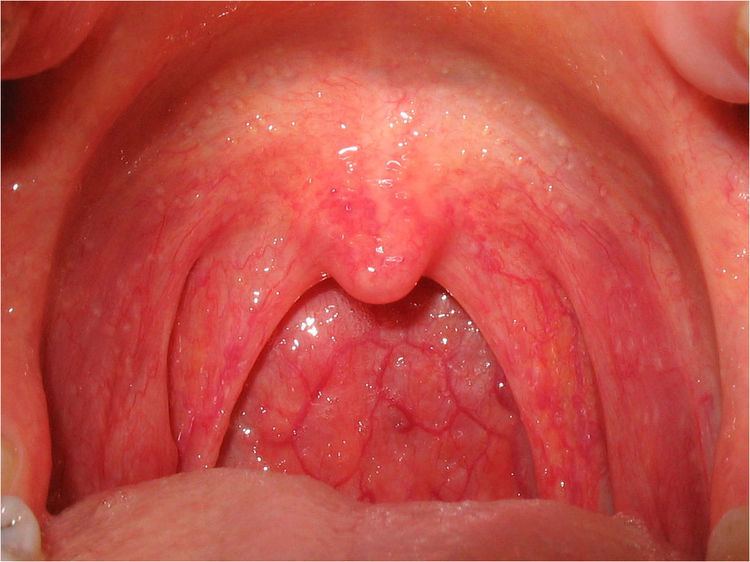Specialty Infectious disease ICD-9-CM 462, 472.1 | Pronunciation /færᵻnˈdʒaɪtᵻs/ ICD-10 J02, J31.2 DiseasesDB 24580 | |
 | ||
Pharyngitis is inflammation of the back of the throat, known as the pharynx. It typically results in a sore throat and fever. Other symptoms may include a runny nose, cough, headache, a hoarse voice. Symptoms usually last three to five days. Complications can include sinusitis and acute otitis media. Pharyngitis is typically a type of respiratory tract infection.
Contents
- Classification
- Cause
- Viral
- Bacterial
- Fungal
- Non infectious
- Diagnostic approach
- Management
- Medications
- Alternative
- Epidemiology
- References
Most cases are caused by a viral infection. Strep throat is the cause in about 25% of children and 10% of adults. Uncommon causes include other bacteria such as gonorrhea, fungus, irritants such as smoke, allergies, and gastroesophageal reflux disease. Specific testing is not recommended in people who have clear symptoms of a viral infection such as a cold. Otherwise a rapid antigen detection test or throat swab is recommended. Other conditions that can produce similar symptoms include epiglottitis, thyroiditis, retropharyngeal abscess, and occasionally heart disease.
NSAIDs, such as ibuprofen, can be used to help with the pain. Topical lidocaine may also help. Strep throat is typically treated with antibiotics, such as either penicillin or amoxicillin. It is unclear if steroids are useful in acute pharyngitis, other than possibly in severe cases.
About 7.5% of people have a sore throat in any three-month period. This resulted in 15 million physician visits in the United States in 2007. Pharyngitis is the most common cause of a sore throat. On the average, adults get a sore throat two to three times a year and children about five times a year. The word comes from the Greek word pharynx meaning "throat" and the suffix -itis meaning "inflammation".
Classification
Pharyngitis is a type of inflammation, most commonly caused by an upper respiratory tract infection. It may be classified as acute or chronic. Acute pharyngitis may be catarrhal, purulent or ulcerative, depending on the causative agent and the immune capacity of the affected individual. Chronic pharyngitis may be catarrhal, hypertrophic or atrophic.
Tonsillitis is a sub type of pharyngitis. If the inflammation includes both the tonsils and other parts of the throat, it may be called pharyngotonsillitis. Another sub classification is nasopharyngitis (the common cold).
Cause
The majority of cases are due to an infectious organism acquired from close contact with an infected individual.
Viral
These comprise about 40–80% of all infectious cases and can be a feature of many different types of viral infections.
Bacterial
A number of different bacteria can infect the human throat. The most common is Group A streptococcus, but others include Streptococcus pneumoniae, Haemophilus influenzae, Bordetella pertussis, Bacillus anthracis, Corynebacterium diphtheriae, Neisseria gonorrhoeae, Chlamydophila pneumoniae, and Mycoplasma pneumoniae.
Streptococcal pharyngitis or strep throat is caused by group A beta-hemolytic streptococcus (GAS). It is the most common bacterial cause of cases of pharyngitis (15–30%). Common symptoms include fever, sore throat, and large lymph nodes. It is a contagious infection, spread by close contact with an infected individual. A definitive diagnosis is made based on the results of a throat culture. Antibiotics are useful to both prevent complications and speed recovery.
Fusobacterium necrophorum is a normal inhabitant of the oropharyngeal flora and can occasionally create a peritonsillar abscess. In 1 out of 400 untreated cases, Lemierre's syndrome occurs.
Diphtheria is a potentially life-threatening upper respiratory infection caused by Corynebacterium diphtheriae which has been largely eradicated in developed nations since the introduction of childhood vaccination programs, but is still reported in the Third World and increasingly in some areas in Eastern Europe. Antibiotics are effective in the early stages, but recovery is generally slow.
A few other causes are rare, but possibly fatal, and include parapharyngeal space infections: peritonsillar abscess ("quinsy"), submandibular space infection (Ludwig's angina), and epiglottitis.
Fungal
Some cases of pharyngitis are caused by fungal infection such as Candida albicans causing oral thrush.
Non-infectious
Pharyngitis may also be caused by mechanical, chemical or thermal irritation, for example cold air or acid reflux. Some medications may produce pharyngitis such as pramipexole and antipsychotics.
Diagnostic approach
It is hard to differentiate a viral and a bacterial cause of a sore throat based on symptoms alone. Thus often a throat swab is done to rule out a bacterial cause.
The modified Centor criteria may be used to determine the management of people with pharyngitis. Based on 5 clinical criteria, it indicates the probability of a streptococcal infection.
One point is given for each of the criteria:
The McIsaac criteria adds to the Centor:
The Infectious Disease Society of America however recommends against empirical treatment and considers antibiotics only appropriate following positive testing. Testing is not needed in children under three as both group A strep and rheumatic fever are rare, except if they have a sibling with the disease.
Management
The majority of time treatment is symptomatic. Specific treatments are effective for bacterial, fungal, and herpes simplex infections.
Medications
Alternative
Gargling salt water is often suggested but evidence looking at its usefulness is lacking. Alternative medicines are promoted and used for the treatment of sore throats. However, they are poorly supported by evidence.
Epidemiology
Acute pharyngitis is the most common cause of a sore throat and, together with cough, it is diagnosed in more than 1.9 million people a year in the United States.
